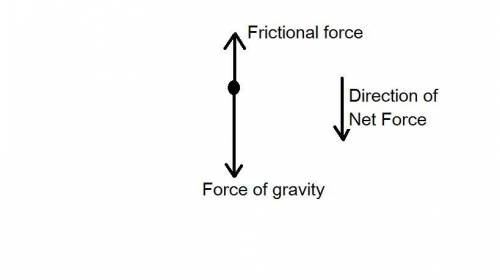
Select all that apply. an acorn falls from a tree. which of the following statements is true? the force of gravity is acting on the acorn. the force of gravity is the only force acting on the acorn. a frictional drag force is acting on the acorn. the net force on the acorn is less than the force of gravity.

Answers: 1
Other questions on the subject: Physics

Physics, 22.06.2019 01:30, chloe1107
Which explanation describes the forces involved for a person to walk down the sidewalk? a. the person's feet push backward on the sidewalk; the sidewalk pushes backward on the person. b. the person's feet push forward on the sidewalk; the sidewalk does not push on the person. c. the person's feet push backward on the sidewalk; the sidewalk pushes forward on the person. d. the person's feet push forward on the sidewalk; the sidewalk pushes forward on the person.
Answers: 1

Physics, 22.06.2019 07:00, jeremiahphillip4396
The speed of sound in ice, water, and steam is shown. what best explains the speed of sound in different states of matter? sound travels fastest in ice because energy is easier to transfer when the molecules are close together. sound travels slowest in steam because the sound has to move around the gas molecules that are far apart. sound travels fastest in ice because the temperature of solids is always greater, so the heat transfers the sound energy. sound travels slowest in steam because the pressure is so great the sound cannot travel though the steam particles.
Answers: 1

Physics, 22.06.2019 09:00, edgarsandoval60
Agroup of students is studying convection currents. they fill two identical balloons with the same amount of helium. one balloon is placed in a freezer and the other in an area with warm air. after 10 minutes, the balloons are released from a height of 1 meter. which of the following do the students most likely observe? question 2 options: the balloons rise at the same rate. both balloons are the same size. the ballons both rise. the cold ballon is larger than the warm balloon. the cold balloon expands and rises. the warm balloon shrinks and sinks. the warm balloon expands and rises. the cold balloon shrinks and sinks.
Answers: 3

Physics, 22.06.2019 11:00, coolfab9338
1.)the isotope cobalt-60 has a nuclear mass of 59.933820 u calculate the mass defect of cobalt-60 using the following information. mass of proton: 1.007825 u mass of neutron: 1.008665 u 1 u = 931.5 mev 2.)the isotope cobalt-60 has a nuclear mass of 59.933820 u calculate the binding energy of cobalt-60 using the following information. mass of proton: 1.007825 u mass of neutron: 1.008665 u 1 u = 931.5 mev 3.)the isotope cobalt-60 has a nuclear mass of 59.933820 u calculate the binding energy per nucleon of cobalt-60 using the following information. mass of proton: 1.007825 u mass of neutron: 1.008665 u 1 u = 931.5 mev
Answers: 3
Do you know the correct answer?
Select all that apply. an acorn falls from a tree. which of the following statements is true? the f...
Questions in other subjects:
















